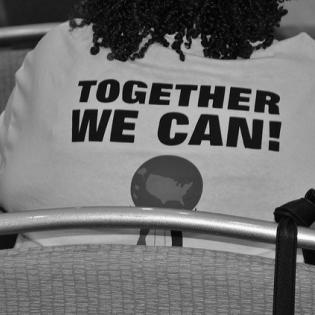Resolving Conflict with Respect
What does it look like to hear all voices in a community? How can we respect others' right to be heard?
In civil society, different people come together to form community. While differences may cause conflict, for the sake of the common good, we practice empathy and respect for others. Students respond to scenarios of differences in opinion. They learn to communicate respectfully with someone of a different opinion and to seek common ground or compromise. The lesson concludes with a service project in which the students create posters to teach these methods to the school or community.
Photo Credit: 2013 Human Rights Training Conference by AFGE is licensed under CC by 4.0
In civil society, different people come together to form community. While differences may cause conflict, for the sake of the common good, we practice empathy and respect for others. We use literature to talk about how people from different perspectives see the same thing. We discuss how to communicate respectfully with someone of a different opinion and to seek common ground or compromise. The service project is to create posters that bring people together.
Photo Credit: 2013 Human Rights Training Conference by AFGE is licensed under CC by 4.0
In civil society, different people come together to form community. While differences may cause conflict, for the sake of the common good, we practice empathy and respect for others. Students respond to scenarios of differences in opinion. They learn to communicate respectfully with someone of a different opinion and to seek common ground or compromise. The lesson concludes with a service project in which the students create posters to teach these methods to the school or community.
Photo Credit: 2013 Human Rights Training Conference by AFGE is licensed under CC by 4.0
The United States is a culturally pluralistic nation, meaning it is comprised of smaller groups within the larger society. These groups maintain their cultural identities, values and practices within the larger construct of the laws and values of the wider society. Although this is the strength of the U.S., it has produced conflicts in our history and today. Conflict is not inevitable and knowing the proper means to communicate and resolve issues can mitigate many problems. This lesson will entail students evaluating the roots of conflicts and methods on how to resolve conflict with respect.
